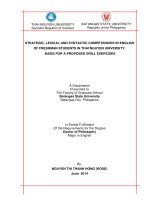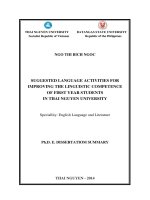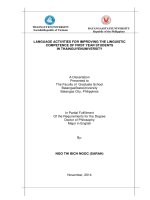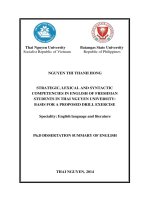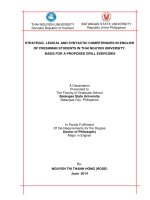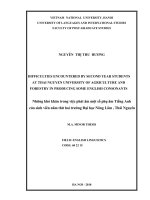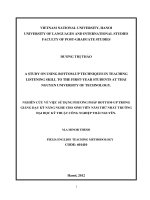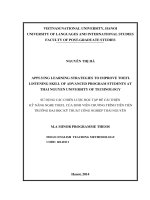Language activites for improving the linguistic competence of first year students in thai nguyen university
Bạn đang xem bản rút gọn của tài liệu. Xem và tải ngay bản đầy đủ của tài liệu tại đây (5.71 MB, 230 trang )
i
THAI NGUYEN UNIVERSITY
Socialist Republic of Vietnam
BATANGAS STATE UNIVERSITY
Republic of the Philippines
LANGUAGE ACTIVITIES FOR IMPROVING THE LINGUISTIC
COMPETENCE OF FIRST YEAR STUDENTS
IN THAI NGUYEN UNIVERSITY
A Dissertation
Presented to
The Faculty of the Graduate School
Batangas State University
Batangas City, Philippines
In Partial Fulfillment
Of the Requirements for the Degree
Of Doctor of Philosophy
Major in English
By:
NGO THI BICH NGOC
April 2015
ii
THAI NGUYEN UNIVERSITY
Socialist Republic of Vietnam
BATANGAS STATE UNIVERSITY
Republic of the Philippines
iii
THAI NGUYEN UNIVERSITY
Socialist Republic of Vietnam
BATANGAS STATE UNIVERSITY
Republic of the Philippines
ABSTRACT
Title
: Language Activities for Improving Linguistic
Competence of the First Year Students in Thai
Nguyen University
Author
: Ngo Thi Bich Ngoc
Degree
: Doctor of Philosophy
Major
: English
Year
: 2015
Adviser
: Dr. Matilda H. Dimaano
Summary
Language is essential in interaction in everyday lives. It is used to give
information to people around us, expressing feelings, desires and questions as
well as understanding the world. Through the use of language, people are able
to communicate with one another, form bonds and teamwork. Without
language a person would not be able to communicate verbally or written, not
be able to read, write or communicate with each other thoroughly orally, written
and electronically. At present, the importance of language is recognized by
many institutions. In learning the complexities of language, creation of a warm
and comfortable environment for the learner is a must.
The purpose of the study is to determine the linguistic competence of
First Year Students of Thai Nguyen University. The study used descriptive
iv
THAI NGUYEN UNIVERSITY
Socialist Republic of Vietnam
BATANGAS STATE UNIVERSITY
Republic of the Philippines
research. The respondents of the study comprised of 382 freshman students
and 66 college teachers. The data gathering instruments utilized includesurvey
questionnaires for the teacher respondents and the teacher made test for the
student respondents. Statistical tools used were frequency, percentage and
rank, linear regression, coefficient of correlation, weighted mean, standard
deviation, and t-test.
The following were the findings of the study: students got an average
level or above 50 percent performance in their linguistic competence along the
areas of connotation, denotation, antonyms, synonyms, ambiguities and
vocabulary as well as in word-formation in the areas of acronym, clipping,
blending and compounding. Relative to the items in the different clusters which
students find most difficult, it was observed that for connotation, the most
difficult item is item 8, for denotation is item 20.
The most difficult item in the test area of antonyms is item 28; for
synonyms, is item 34; in the case of ambiguities, it is item 44; and for the
vocabulary test, it is item 55. In word formation, it can be observed that for
acronym, the most difficult item is item 69, for clipping is item 74 while for
blending, it is item 87. For compounding, the most difficult item is item 93.
In the teachers‟ assessments of the linguistic and word- formation
v
THAI NGUYEN UNIVERSITY
Socialist Republic of Vietnam
BATANGAS STATE UNIVERSITY
Republic of the Philippines
competencies, six skills which included four skills in linguistic area and two
skills in the word- formation area showed rank differences of 10 or less,
indicating that these were the skills where the perception of the teachers were
relatively congruent which revealed that they had unclear understanding of the
abstract concepts of linguistic and word formation areas and their test
application.
In the relationship between the teachers‟ assessment and the level of
students‟ linguistic and word formation competencies it was observed that
among the 11 mean combinations being compared, all showed significant pvalues at 0.05 significant level. This tend to the rejection of the null hypothesis
of no significant relationships.
Language activities were designed based on the four indicated skill
areas and belong to linguistic skills and none from word formation skills. It was
only in the four areas of linguistic skills that the students need language
activities for them to cope with their skills requirement. Recommendations of
the study include providing students with exposures on varied learning
activities to enhance further their linguistic competencies; presenting the
developed language activities to language teachers for further suggestions;
and conducting further study on other components of communicative
competence maybe done.
vi
THAI NGUYEN UNIVERSITY
Socialist Republic of Vietnam
BATANGAS STATE UNIVERSITY
Republic of the Philippines
ACKNOWLEDGMENT
The researcher would like to convey her deepest gratitude and sincerest
appreciation to the following persons whose valuable contributions have
helped much to make this academic work a reality:
To Dr. Matilda H. Dimaano, dissertation adviser, who tirelessly worked on
reading version after version of this manuscripts, and for providing valuable
inputs and insightful comments that improved this study as well as for the
encouragement and assistance that facilitated its completion;
Dr. Nguyen The Hung, director of International Training and Consultancy
Center for his encouragement;
To the panel members: Dr. Ma. Luisa Valdez, Dr. Amada Banaag, Dr. Felix
Panopio, Dr. Myrna G. Sulit, Dr. Remedios P. Magnaye for their valuable insights
which greatly improved this work;
The teachers and the student respondents of the study for their active
involvement and cooperation;
To her friends for their encouragement and support; and
To her parents and siblings for their love, concern and understanding and
for being an inspiration in pursuing this academic endeavor.
vii
THAI NGUYEN UNIVERSITY
Socialist Republic of Vietnam
BATANGAS STATE UNIVERSITY
Republic of the Philippines
DEDICATION
This dissertation is dedicated to my loving and ever supportive husband,
Mr. Le Huy and my loving son, Le Minh, to my family, and to my dear Thai
Nguyen University community
Ngo Thi Bich Ngoc
viii
THAI NGUYEN UNIVERSITY
Socialist Republic of Vietnam
BATANGAS STATE UNIVERSITY
Republic of the Philippines
TABLE OF CONTENTS
Page
TITLE PAGE ............................................................................................ i
APPROVAL SHEET ................................................................................ii
ABSTRACT ............................................................................................. iii
ACKNOWLEDGMENT............................................................................ vi
DEDICATION.........................................................................................vii
TABLE OF CONTENTS…………………………………………………… viii
LIST OF TABLES…………………………………………………………… xi
LIST OF FIGURES.................................................................................xiii
CHAPTER
I. THE PROBLEM
Introduction ............................................................................ 1
Statement of the Problem ...................................................... 7
Scope, Delimitation and Limitation of the Study .................... 8
Significance of the Study ....................................................... 9
II. REVIEW OF LITERATURE
Conceptual Literature .......................................................... 11
Research Literature ............................................................. 52
Synthesis .............................................................................. 59
Theoretical Framework ....................................................... 63
ix
THAI NGUYEN UNIVERSITY
Socialist Republic of Vietnam
BATANGAS STATE UNIVERSITY
Republic of the Philippines
Conceptual Framework ....................................................... 65
Hypothesis ........................................................................... 68
Definition of Terms ............................................................... 68
III. RESEARCH METHOD AND PROCEDURE
Research Environmen………………………………………...71
Research Design ................................................................ 73
Subjects of the Study .......................................................... 74
Data Gathering Instrument .................................................. 76
Data Gathering Procedure ................................................... 78
Statistical Treatment of Data ............................................... 80
IV. PRESENTATION, ANALYSIS AND INTERPRETATION OF
DATA ................................................................................... 81
V. SUMMARY, CONCLUSION AND RECOMMENDATION
Summary of Findings ......................................................... 139
Conclusions ....................................................................... 155
Recommendations ............................................................. 157
BIBLIOGRAPHY ................................................................................... 158
APPENDICES
A. Test for Students .................................................................... 167
x
THAI NGUYEN UNIVERSITY
Socialist Republic of Vietnam
BATANGAS STATE UNIVERSITY
Republic of the Philippines
B. Questionnaire for Teachers .................................................. 187
C. Validation Letter 1 on the Test for Students & Teachers
Questionnaire ......................................................................... 193
D. Validation Letter 2 on the Test for Students & Teachers
Questionnaire ........................................................................ 194
E. Validation Letter 3 on the Test for Students & Teachers
Questionnaire ......................................................................... 195
F. Letter of Request to the Heads of Institutions ........................ 196
G. Response Letter of the Heads of Institutions ......................... 201
H. Photographs of the Study Sites ............................................. 202
I.
Photographs of Students Respondents ................................. 203
J. Photographs of Teacher Respondents .................................. 206
K. Photographs of Teacher-Made Test and Survey Questionnaire
Validation ................................................................................ 207
L. Psychrometric Conversion Table……………………………...208
CURRICULUM VITAE
xi
THAI NGUYEN UNIVERSITY
Socialist Republic of Vietnam
BATANGAS STATE UNIVERSITY
Republic of the Philippines
LIST OF TABLES
Table
Title
Page
1
Distribution of Sample Respondents..................................75
2
Performance of Students‟ Linguistics Test....................................82
3
Performance of Students‟ Word- Formation Test...............93
4a
Most Difficult Items in Linguistic Test.................................100
4b
Most Difficult Items in Linguistic Test.................................101
5
Most Difficult Items in Word- Formation Test....................105
6a
Students‟ Skills Perceived as Linguistic/
Word-Formation Competencies.........................................110
6b
Students‟ Skills Perceived as Linguistic/
Word- Formation Competencies........................................111
7
Students‟ Linguistic Skills According to
the Frequency of Use.............................................................112
8
Students‟ Linguistic Skills According to
the Degree Importance......................................................114
9
Comparison of the Teachers‟ Perception
and Students‟ Performance in Linguistics
and Word- Formation.........................................................116
xii
THAI NGUYEN UNIVERSITY
Socialist Republic of Vietnam
10
BATANGAS STATE UNIVERSITY
Republic of the Philippines
Areas in Linguistic Competencies as
Bases for the Design of Language
Activities..............................................................................119
xiii
THAI NGUYEN UNIVERSITY
Socialist Republic of Vietnam
BATANGAS STATE UNIVERSITY
Republic of the Philippines
LIST OF FIGURES
Figure
1
Title
Page
Research Paradigm on the Linguistic
Competence of First Year Students in
Thai Nguyen University...........................................67
1
THAI NGUYEN UNIVERSITY
Socialist Republic of Vietnam
BATANGAS STATE UNIVERSITY
Republic of the Philippines
CHAPTER I
THE PROBLEM
Introduction
In our world today, language is our means of communication and
learning.
It is one‟s knowledge and a tool of expression of thoughts,
perceptions and sentiments. Thoughts and ideas can never be expressed and
can‟t be understood by one another without good language.
Language is considered important because it is the vehicle for
communication between countries, cultural groups, various companies,
organization, communities and friends.
It also represents a fundamental
expression of social identity. As a mirror that allows a person to understand
what one is thinking, language is considered complex and constantly evolving.
It allows cultures with their shared set of values, customs and history to exist
and as a part of speech language is important for one‟s survival for it forges
friendship, cultural ties and economic relationship.
Thoughts and emotions are shaped by language and it also determines
one‟s perceptions and reality. It is considered the light of the mind and its
retention helps maintain feeling of cultural kinship. Knowledge of the English
language is one of most important aspect for the learners for it is considered
2
THAI NGUYEN UNIVERSITY
Socialist Republic of Vietnam
BATANGAS STATE UNIVERSITY
Republic of the Philippines
the key factor to competitiveness. Because language enables people to
communicate and express themselves, it becomes an important part of any
society.
As a currency used in exchanging ideas, language is considered the
simple greatest skill an individual should possess and master.
It holds
societies together and mankind evolves, grows and prospers through
language. It is the key that unlocks minds.
In everyday lives, language is essential in interaction. Language is use
to give information to people around us, expressing
feelings, desires and
questions as well as understanding the world.
In varied situations
communication is done effectively through words, gestures and tone of voice.
Through the use of language, people are able to communicate with one
another, form bonds and teamwork. Without language a person would not be
able to communicate verbally or written, not be able to read, write or
communicate with each other thoroughly. With language, one would have the
ability to transmit and transport ideas orally, written and electronically.
At present, the importance of language is recognized by many
institutions. Second language teaching is being offered by some schools as
early as middle school and they are requiring specific language requirements
for those who would like to study in the schools.
3
THAI NGUYEN UNIVERSITY
Socialist Republic of Vietnam
BATANGAS STATE UNIVERSITY
Republic of the Philippines
In learning the complexities of language, creation of a warm and
comfortable environment for the learner is a must. It is of vital importance that
learner must develop his communication skill since this will serve as the
foundation
of
his
future
communication
abilities.
Having
effective
communication skills serve as an asset for lifetime quality communication.
Learning other language besides the national language is also of vital
importance since it helps to have additional knowledge of other people and
cultures. One‟s knowledge of mother tongue is also considered important to
preserve identity as language is said to be logical code apart from social and
cultural actions. It is also fundamental to have knowledge on the concept of
language to understand the teaching practice of foreign language.
It is
impossible for teachers to develop any kind of effective and successful
communication among learners as well as any kind of sharing of ideas without
language.
As a system of linguistic knowledge which is possessed by all and any
speakers of a language, linguistic competence is a universal property,
common to all human beings, regardless of race, economic class or physical
characteristics, independent of his/her intellectual and personality attributes.
The speaker is allowed by this system to go from a finite number of rules
specific of any language to the production of an infinite number of new
4
THAI NGUYEN UNIVERSITY
Socialist Republic of Vietnam
BATANGAS STATE UNIVERSITY
Republic of the Philippines
sentences.
Distinguishing grammatical sentences from ungrammatical ones is
covered in linguistic competence. It is wrong to say that language is taught and
misleading to say that it is being learned albeit language is not learned but it
grows in the mind of a person. For creativity of language that is the speaker‟s
ability to produce new and different sentences which constitute dialogue to
take place, grammatical sentences should be immediately understood by the
hearer every time conversation which is the most notable aspect of
competence is established. Knowledge of language in an abstract way is also
important in linguistic competence.
This plays a major role when linguistic,
social and cultural knowledge are mixed.
It is stated that 70 percent of English Language happened among nonnative speakers and that language teachers must have the knowledge that
English language is not exclusive to English native speakers only. So it is not
the best solution for teachers to teach English focusing on native speaker‟s
interaction since learners interact with other people from different linguistic and
cultural communities.
In learning English as a foreign language, students most common
difficulties encountered are attributed to the interference of their mother tongue
like Vietnamese language particularly in pronunciation, syntax, and usage;
5
THAI NGUYEN UNIVERSITY
Socialist Republic of Vietnam
BATANGAS STATE UNIVERSITY
Republic of the Philippines
their lack of opportunity also to use the English language in some
communication or situations in their daily lives; the kind of English lessons
taught by their teachers, their being passive listeners, shyness to use English
language in conversation in class or their lack of confidence in the language;
and their irresponsibility in their own learning. Their poor performance in
English is also attributed to students‟ wrong perceptions of learning as they
tend to be more focus on other activities such as taking examinations and out
class activities whereby learning is affected as they no longer equate learning
with broadening knowledge which rendered learning or studying the language
not interesting or worthy to students causing negative effects on their learning
experiences.
These causes can also be related to other issue like that of their problem
or lack of understanding of words or vocabulary. In the field of literacy,
relationship between students‟ vocabulary knowledge and their reading
comprehension is considered one of the best. It is believed that students who
were taught many vocabulary words tend to become better readers and
writers. Relationship between words and concepts is developed through
effective vocabulary instruction. Considered the basic units of thoughts and
beliefs are concepts and these are labelled as words. So that, if there is
6
THAI NGUYEN UNIVERSITY
Socialist Republic of Vietnam
BATANGAS STATE UNIVERSITY
Republic of the Philippines
familiarity in concept, then the corresponding word to this underlying
knowledge is clearly understood, recalled and utilized.
Students‟ experiences help in the development of concepts. Reading
and writing are contributory factors in the growth of concepts which in turn
make students understand and use more words. It is believed that students‟
vocabulary increase when they elaborate their conceptual knowledge based
on known words; relate new words to known concepts or existing words since
deep understanding of words richly expound and connect with other concepts.
On the other hand, students need to have good intuitive command of
morphology. They have knowledge in specific morphemic elements and its
combinations. They can explore on the use of prefixes and suffixes and based
words and on Greek and Latin prefixes for them to be provided with valuable
prior knowledge in their learning of new terminologies.
Students with better understanding on word formation such as prefixes,
suffixes and roots have the tendency to acquire larger vocabularies and better
comprehension in compared to those who do not have such background,
knowledge and skills. Having full knowledge and understanding of vocabulary
improve students‟ outcomes.
As a College teacher of Thai Nguyen University teaching Basic English,
the researcher is interested to investigate the level of linguistic competence of
7
THAI NGUYEN UNIVERSITY
Socialist Republic of Vietnam
BATANGAS STATE UNIVERSITY
Republic of the Philippines
students in English in terms of connotation, denotation, antonyms, synonyms,
and ambiguities as well as the level of students‟ understanding on word
formation relative to acronym, clipping, blending, and compounding with the
end view of proposing language activities to enhance their linguistic
performance. This prompted the researcher to conduct the study.
Statement of the Problem
This study attempts to determine the level of Linguistic Competence of
the First Year Students at Thai Nguyen University.
Specifically, it sought answer the following questions:
1. What are the levels of linguistic competence using the following as revealed
in the results of the Teacher Made Linguistic Test:
1.1 connotation;
1.2 denotation;
1.3 antonyms;
1.4 synonyms;
1.5 ambiguities; and
1.6 vocabulary?
2. What are the levels of understanding of students on word-formation
in terms of :
2.1 acronym;
8
THAI NGUYEN UNIVERSITY
Socialist Republic of Vietnam
BATANGAS STATE UNIVERSITY
Republic of the Philippines
2.2 clipping;
2.3 blending; and
2.4 compounding?
3. Which among the items in the different cluster do students find most
difficult?
4.
How do the teachers assess the linguistic and word-formation
competencies of the students?
5.
Are there significant relationships between teachers‟ assessments
and the levels of students‟ linguistic and word-formation competencies?
6. What English language activities may be suggested to improve
students‟ understanding of English words and concepts?
Scope, Delimitation and Limitation of the Study
The study covered the level of linguistic competency of Thai Nguyen
University first year students specifically on connotation, denotation, antonyms,
synonyms, and ambiguities, as well as their level of understanding on wordformation in terms of acronyms, clipping, blending, and compounding. The
output of the study is the proposed language activities to enhance the linguistic
competency of first year students of Thai Nguyen University.
The respondents included in the study were the 500 First year College
9
THAI NGUYEN UNIVERSITY
Socialist Republic of Vietnam
BATANGAS STATE UNIVERSITY
Republic of the Philippines
students taking up Basic English course in Thai Nguyen University system
inthe Academic Year 2013-2014. Students who were in their Second year to
Fourth year level were not included in the study. Results of this research study
were limited only on the data gathered from the respondents in the Academic
Year 2013-2014 in Thai Nguyen University system.
Significance of the Study
This study is significant to the Administrators of Thai Nguyen University,
First Year Students, Basic English teachers, Parents of First Year Students,
the current researcher and future researchers.
Administrators. Findings of this study will provide relevant input for
them to be able to design an effective curriculum for the students.
Administrators can utilize the results of the study by providing Faculty
Development Training program for the teachers to improve their classroom
language teaching.
First Year Students of TNU. This study will serve as input for them to
be aware of their linguistic performance.
They will be informed on their
weaknesses so that they can devise ways to improve their linguistic
performance.
Faculty Teaching Basic English. Results of this study will provide
10
THAI NGUYEN UNIVERSITY
Socialist Republic of Vietnam
BATANGAS STATE UNIVERSITY
Republic of the Philippines
relevant information to the faculty teaching Basic English course for them to
design their own instructional material to enhance the linguistic proficiency of
students.
Parents of First Year Students of TNU. Findings of this study will
provide them useful information on the present performance of their children in
Linguistic. Through this study, parents as they become aware of the
weaknesses of their children may provide proper guidance and motivation for
their children‟s improvement.
Current Researcher. This study will provide the current researcher the
opportunity to apply her knowledge and skills gained in providing answers to
linguistics problems confronting the students of Thai Nguyen University and
develop tools that could be used by teachers and administrators to address
these linguistic problems.
Future Researchers. This will be of use to other researchers who might
wish to conduct a similar study. Future researchers
broaden their knowledge in the field of linguistics.
may use this study to
11
THAI NGUYEN UNIVERSITY
Socialist Republic of Vietnam
BATANGAS STATE UNIVERSITY
Republic of the Philippines
CHAPTER II
REVIEW OF LITERATURE
This chapter presents the review of conceptual and research literatures
which have bearing to the present study. Further, synthesis, theoretical and
conceptual frameworks as well as the hypothesis, operational and conceptual
definitions of terms are also included.
Conceptual Literature
The following concepts provide a conceptual frame of reference to this
study. These include language component, linguistic competence, vocabulary
development, and language activities.
Language Component. A human system of communication that uses
arbitrary signals such as voice sound, gestures or written symbols is termed as
language.
As a system of communication using sounds or symbols that
enables a person to express his feelings, thoughts, ideas and experiences
(Goldstein, 2008) a language consists of symbols that can be used to generate
an infinite variety of messages (Weiten, 2007). It is something which arises
out from work, needs, ties, joy, affection, tastes of human beings. . Language
is not merely a human and non-instinctive method of communicating ideas,
emotions and desires by means of voluntarily produced symbols (Sapir, 1921),
but it is also a behavior that involves body parts like the vocal apparatus and
12
THAI NGUYEN UNIVERSITY
Socialist Republic of Vietnam
BATANGAS STATE UNIVERSITY
Republic of the Philippines
the auditory system for the oral language; the areas of the head and the neck
and the visual system for sign language where such body parts are controlled
by none other than the brain for their functions (Peng, 2006). Chomsky (1957)
on the other hand pointed out that language is a set of finite or infinite
sentences, each finite in length and constructed out of a finite set of elements
while Trager (1942) defined language as a system of arbitrary vocal symbols
by means of which a social group cooperates.
Language encompasses fully developed primary system such as
English including both phonology and syntax. Chomsky (1982) emphasized
that language is an entity in and of itself and that the systematicity observed
in language is due to language principles and further explained that
language is not an instantiation of motor abilities or a subset of cognition
and it does not follow from any mental or behavioral source.
English language consists of five components. These include phonology,
morphology, syntax, semantics and pragmatics. A good language learner must
be aware of these in language learning. Phonology as a distinct component of
language is concerned with sounds and gestures and abstract units such as
distinctive features, phonemes, mora, syllables and others and their
conditioned variation via allophonic rules, constraints for derivational rules
(Kingston, 2007). It relates to phonetics via the set of distinctive features


